Related Research Articles

Bijie is a prefecture-level city in northwestern Guizhou Province, China, bordering Sichuan to the north and Yunnan to the west.

Wen County or Wenxian is a county under the administration of the prefecture-level city of Longnan, in the southeast of Gansu province, China, bordering Sichuan province to the south and west. It has a land area of 4,994 square kilometers, and a population of 241,000 (2019), notably having the largest population of Baima people.
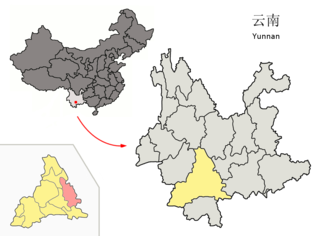
Mojiang Hani Autonomous County is an autonomous county under the jurisdiction of Pu'er City, in the south of Yunnan Province, China.

Zhengning County is a county in the east of Gansu province, China, bordering Shaanxi province to the east and south. It is under the administration of the prefecture-level city of Qingyang. Its postal code is 745300, and its population in 1999 was 225,043 people.
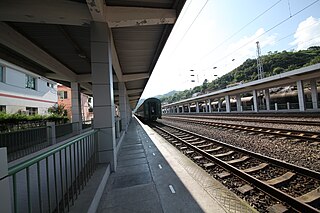
Ningqiang County is a county and both the southwesternmost and westernmost county-level division of Shaanxi province, China, bordering both Sichuan and Gansu. It is under the administration of Hanzhong City. The source of the Han River is located in the county.

Guanling Buyei and Miao Autonomous County is an autonomous county in Anshun City, in the southwest of Guizhou Province, China.

Yongqing is a county in Hebei province, China. It is under the administration of the prefecture-level city of Langfang. It borders Guangyang District to the north, Anci District to the east, Bazhou to the south, and Gu'an County to the west, and has a population of 382,000 residing in an area of 774 km2 (299 sq mi).
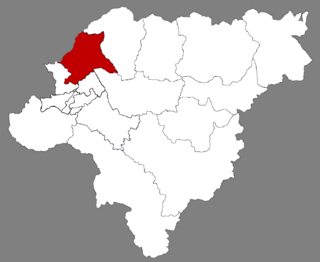
Hulan District is one of nine districts of the prefecture-level city of Harbin, the capital of Heilongjiang Province, Northeast China. It covers part of the northeastern suburbs. The district was approved to establish from the former Hulan County (呼兰县) by the Chinese State Council on February 4, 2004. It borders Bayan County to the east, Bin County to the southeast, Daowai District to the south, and Songbei District to the southwest, as well as the prefecture-level city of Suihua to the northwest.
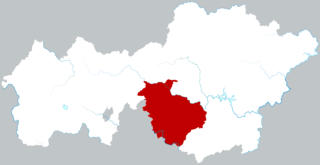
Nayong County is a county in the west of Guizhou province, China. It is under the administration of Bijie city. It is rich in natural resources: coal, lead, zinc, marble, sulfur, iron, fluorite, dolomite, limestone and others. A significant portion of Guizhou's coal production is extracted in Nayong. Nayong's marble is famous in China, and the annual production is 1,400,000 cubic metres (49,000,000 cu ft). For agriculture, timber, tobacco, walnut and tea are some products of importance. In 2016, the total GDP was RMB 18,900,000,000, with a GDP per capita of RMB 27,843.
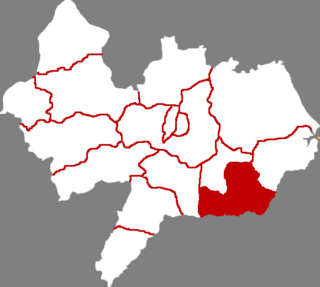
Yanshan County is a county in the east of Hebei province, China, bordering Shandong to the south and east. It is under the administration of Cangzhou City, and it has a population of 410,000 residing in an area of 795 km2 (307 sq mi). China National Highway 205 runs northwest-southeast through the county.
The U language or P'uman, is spoken by 40,000 people in the Yunnan Province of China and possibly Myanmar. It is classified as an Austroasiatic language in the Palaungic branch. In China, U speakers are classified as ethnic Bulang.
Kaduo is a Southern Loloish language spoken in Mojiang, Jiangcheng, Ning'er, Zhenyuan, and Xinping counties of Yunnan, China by about 20,000 people.

The Mienic or Yao languages are spoken by the Yao people of China, Vietnam, Laos, and Thailand.

A major cultural heritage site under national-level protection (全国重点文物保护单位) is the highest protection level approved by China for immovable cultural relics.
Awu, also known as Lope, is a Loloish language of China. Awu is spoken in Luxi, Mile, Luoping, and Shizong counties (Ethnologue). It is closely related to Nisu.
The Hani languages are a group of closely related but distinct languages of the Loloish (Yi) branch of the Tibeto-Burman linguistic group. They are also referred to as the Hanoid languages by Lama (2012) and as the Akoid languages by Bradley (2007).
Nuomei is a Southern Loloish language of Yunnan, China. Nuomei is spoken in Yuanjiang Hani, Yi and Dai Autonomous County, and Jinping Miao, Yao, and Dai Autonomous County.
Taloid is a cluster of languages in the Lisoish branch of Lolo–Burmese.
Badong Yao is an unclassified Sinitic language spoken by the Yao people in Xinning County, Hunan province, China. Badong Yao is currently endangered, and is spoken in the villages of Huangyandong 黄岩峒, Malindong 麻林峒, and Dazhendong 大圳峒 in Huangjin Ethnic Yao Township 黄金瑶族乡, Xinning County. It is also spoken in Malin Ethnic Yao Township 麻林瑶族乡, located just to the east of Huangjin Township.
The Lienchiang Cross-Strait Matters Forum is a forum between Lienchiang County of the Republic of China (ROC) and Lianjiang County of the People's Republic of China (PRC) which started in 2019.